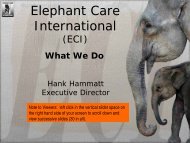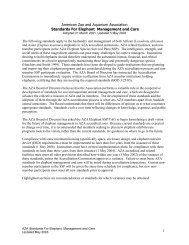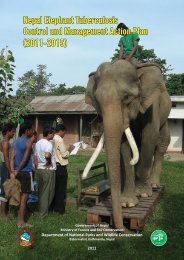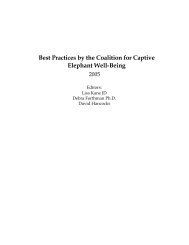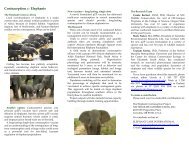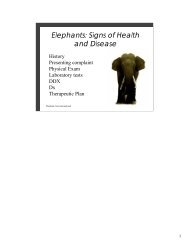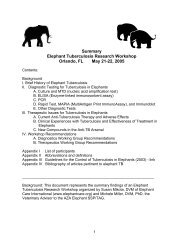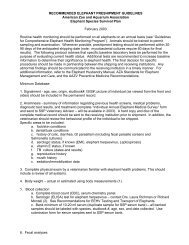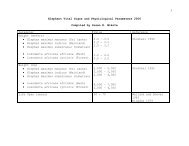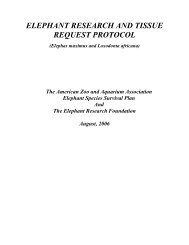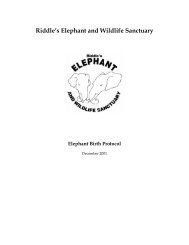Elephants Elephants - Wildpro - Twycross Zoo
Elephants Elephants - Wildpro - Twycross Zoo
Elephants Elephants - Wildpro - Twycross Zoo
- No tags were found...
Create successful ePaper yourself
Turn your PDF publications into a flip-book with our unique Google optimized e-Paper software.
fitness and a sense of well-being and the animal MUST be protected fromunnecessary suffering. The captive environment may be markedly differentfrom that in which the species evolved. For example in the wild elephantsmay spend up to 16 hours a day feeding, but in captivity this may becompressed to a much shorter time scale. This difference in feeding timebetween the captive and wild state requires a coping response. The degree ofdifference between the two regimes in terms of time budgeting could beconsidered to be an indicator of the extent to which an individual animal’swelfare may be compromised.Welfare can also be defined as a state in which an animal can fulfil itsneeds/wants (Stafleu et al 1996), these may be biological or physical, thefulfilment of which is necessary to cope with the environment and cognitiveneeds are sometimes included in this. However, only certain behaviourrepresents what can be described as a need, i.e. that which, when notexpressed by the animal, results in suffering. For example foraging (i.e.feeding) behaviour can be considered as a need, in that it has a high survivalvalue and is driven by an almost omnipresent stimulus to feed. Sincedifferent species allocate different amounts of time to feeding, the extent towhich an animal suffers due to the non-performance of this behaviour willvary. This means that a snake, which hunts infrequently, if denied theopportunity to hunt, will suffer less than a pig denied the opportunity toforage (Appleby 1999), thus animals like elephants, although they areprovided with sufficient food in a nutritional sense, may not be provided withsufficient as regards time spent feeding (Shepherdson 1999). Anti-predatorbehaviour (e.g. escape responses), on the other hand, has a high survival valuebut is probably not a need as it is only expressed when the stimulus of apredator is present.<strong>Zoo</strong>s should strive to provide an environment in which captive elephants arerequired to make the least effort in order to cope which can be achieved byproviding for the expression of their behavioural needs (Poole and Taylor1999) (and see Section 3.5, Elephant Behaviour and Captivity). Attempts tomeasure welfare can be made using indicators such as adrenal activity,activity levels, levels of stereotypy, degree of immune-suppression, severity ofinjury, reproductive output, level of disease prevalence, mortality rate etc.These measurements are often impractical and many measures of welfaredifficult to interpret (Mason and Mendl 1993), and can only be taken as aguide; however more data relevant to elephants would be extremely useful, inhelping to inform management decisions. Further information on behaviourand the captive environment is provided in Section 3.5.It is therefore useful to have guidance on how to judge welfare, so that bettermanagement practices can be developed without relying on the absolute needto prove whether or not suffering is present. For this the five principles listedin the Secretary of State’s Standards on Modern <strong>Zoo</strong> Practice (SSSMZP) areuseful.Provision of Food and WaterAlthough an animal may be given sufficient calories and nutrients, if it isgiven them in concentrated form, it may still suffer from feelings of hunger36



